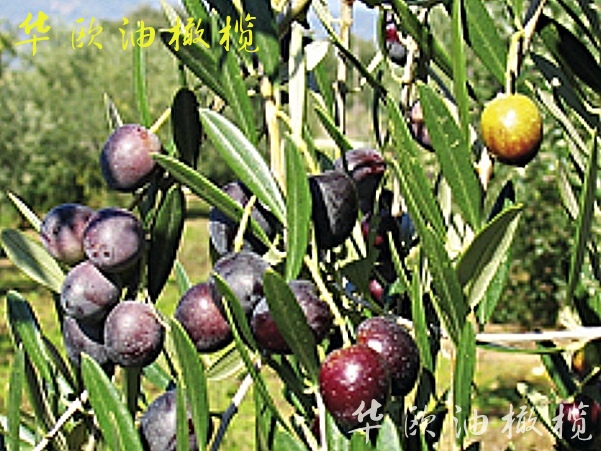奇奇蒂塔橄榄‘Chiquitita’ Olive
- Departamento de Agronomía, Universidad de Córdoba, Campus de Rabanales, Edificio Celestino Mutis, Carretera Madrid-Cádiz, km 396, E-14080, Córdoba, Spain
+Author Affiliations -作者联系
‘Chiquita’(译名:奇奇蒂塔,橄榄小姑娘树)是一种新的橄榄(Oela Eulaa. L.)品种,是在西班牙C.Rordba的杂交育种中获得的。“Chiquitita”来源于1991年在“Picual(皮瓜儿)”和“Arbequina(阿尔贝吉纳)”之间进行的杂交,这两个品种的生产力和含油量都来自不同的地理来源:西班牙东北部加泰罗尼亚的“Arbequina”和南部安达卢西亚的“Picual”。西班牙(拉洛,1995)。在柯尔多瓦进行的农艺评价的结果允许最终选择“Chiquitita”作为具有早生、高含油量和产量效率的新橄榄品种。它的低活力和紧凑和哭泣的生长习性使得它特别适合于高密度篱笆果园。“Chiquitita”是由科尔多瓦大学和农业和渔业研究训练研究所(IFAPA)合作育种项目开发的第一个橄榄品种。
‘Chiquitita’ is a new olive (Olea europaea L.) cultivar obtained in a crossbreeding program in Córdoba, Spain. ‘Chiquitita’ was derived from a cross carried out in 1991 between ‘Picual’ and ‘Arbequina’, two cultivars with high productivity and oil content from different geographical origins: ‘Arbequina’ from Catalonia in the northeast of Spain and ‘Picual’ from Andalusia in the south of Spain (Rallo, 1995). The results of the agronomical evaluation carried out in Córdoba allow the final selection of ‘Chiquitita’ as a new olive cultivar with early bearing, high oil content, and yield efficiency. Its low vigor and compact and weeping growth habit make it particularly adapted to high-density hedgerow orchards. ‘Chiquitita’ is the first olive cultivar developed by the cooperative breeding program carried out by the University of Córdoba and the Institute of Agricultural and Fishery Research and Training (IFAPA)
Origin
起源
“Chiquitita”(育种记录中的后代UC-I 8-7)的原始幼苗来源于1991年进行的“Picual”(雌性)和“Arbequina”(雄性)杂交。在1994年的田间试验中,在C.Rordba的IFAPA Caloto ALAMDA DEBOBISPO的试验场中进行了幼苗的种植。1996获得第一茬,连续三个收获季节进行苗木鉴定。“Chiquitita”的原苗主要根据其早熟(幼龄期短)和高含油量来选择,还表现出紧凑和哭泣的生长习性(Len等人,2004)。选择15个基因型,包括“Chiquitita”和以前引用的3个生殖器作为对照,于2000年春季通过半硬木茎扦插繁殖,并于2001年7月在位于科尔多瓦的阿拉米达中部奥比斯波的IFAPA实验农场进行了比较试验。一个随机块设计与16个重复和一棵树每个基本图使用。对基因型的评价证实了先前在苗期记录的结果,并允许最终选择“Chiquitita”作为新的橄榄品种。在高密度灌木篱果园中的一个新的比较田间试验已经在2007种植。目前正在西班牙的多个地点进行更多的对比试验。
The original seedling of ‘Chiquitita’ (progeny UC-I 8-7 in the breeding records) was derived from a cross between ‘Picual’ (female) and ‘Arbequina’ (male) carried out in 1991. The seedling was planted in the field in 1994 at the experimental farm of IFAPA Centro Alameda del Obispo of Córdoba. The first crop was obtained in 1996 and seedling evaluation was carried out for three consecutive harvest seasons. The original seedling of ‘Chiquitita’ was selected mainly on the basis of their early crop (short juvenile period) and high oil content, showing also compact and weeping growth habit (León et al., 2004). Fifteen selected genotypes, including ‘Chiquitita’, and the three previously cited genitors used as controls were propagated by semihardwood stem cuttings in Spring 2000 and planted in a comparative trial at the experimental farm of IFAPA Centro Alameda del Obispo of Córdoba in July 2001. A randomized block design with 16 replications and one tree per elementary plot were used. The evaluation of the genotypes confirmed the previous results recorded at the seedling stage and allowed the final selection of ‘Chiquitita’ as a new olive cultivar. A new comparative field trial with ‘Chiquitita’ in high-density hedgerow orchards has been already planted in 2007. More comparative trials are currently planned in several locations in Spain.
Description
描述
形态学描述是根据Balrango等人进行的。(2000)利用树、叶、果、内果皮共25个性状。利用10个微卫星位点,利用分子标记进行品种鉴定,这些微卫星位点先前用于育种计划中的亲子鉴定(Daz等人,出版社)。农学描述考虑了“Chiquitita”在原始育苗场进行的农学评价结果和在科尔多瓦阿拉米达中部奥比斯波试验农场建立的比较田间试验的结果。由于高密度篱笆果园似乎是该新品种的主要直接应用,因此将“Chiquitita”的农艺结果与目前用于该新果园系统的标准品种“Arbequina”进行了比较。
Morphological description was carried out according to Barranco et al. (2000) by using a total of 25 characters of the tree, leaf, fruit, and endocarp. Cultivar identification by molecular markers was performed with 10 microsatellite loci previously used for paternity testing in the breeding program (Díaz et al., in press). Agronomical description takes into account the results of the agronomical evaluation of ‘Chiquitita’ carried out in the original seedling field and the comparative field trial established both at the experimental farm of IFAPA Centro Alameda del Obispo of Córdoba. Because high-density hedgerow orchards seem to be the main direct application of this new cultivar, agronomical results of ‘Chiquitita’ are compared with those of ‘Arbequina’, the standard variety currently used for this new orchard system.

新橄榄品种选育适合高密度配制果园。由科尔多瓦大学和安达鲁兹农业研究所(IFAPA)的研究人员在1991年开始执行的橄榄育种计划中获得。它起源于“Picual”(雌性亲本)和“Arbequina”(雄性亲本)之间的杂交,这两个品种在西班牙橄榄园中更广泛地传播。其中树木的数量达到907橄榄树/公顷。由于其活力很低,可以采用4×12的种植空间。
该品种在欧盟、智利、阿根廷、墨西哥、美国(命名为“Chiquitita”)、南非、澳大利亚、突尼斯、摩洛哥和土耳其受到保护。


